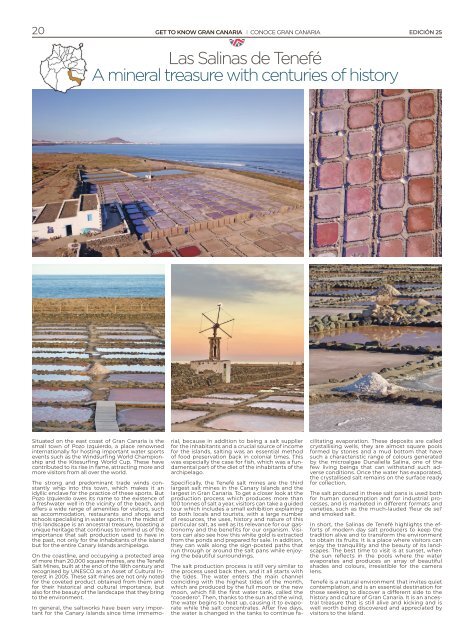No. 25 - Its Gran Canaria Magazine
Rutas, recomendaciones y noticias de Gran Canaria. Routes, tips and news about Gran Canaria.
Rutas, recomendaciones y noticias de Gran Canaria.
Routes, tips and news about Gran Canaria.
You also want an ePaper? Increase the reach of your titles
YUMPU automatically turns print PDFs into web optimized ePapers that Google loves.
20<br />
GET TO KNOW GRAN CANARIA I CONOCE GRAN CANARIA EDICIÓN <strong>25</strong><br />
Las Salinas de Tenefé<br />
A mineral treasure with centuries of history<br />
Situated on the east coast of <strong>Gran</strong> <strong>Canaria</strong> is the<br />
small town of Pozo Izquierdo, a place renowned<br />
internationally for hosting important water sports<br />
events such as the Windsurfing World Championship<br />
and the Kitesurfing World Cup. These have<br />
contributed to its rise in fame, attracting more and<br />
more visitors from all over the world.<br />
The strong and predominant trade winds constantly<br />
whip into this town, which makes it an<br />
idyllic enclave for the practice of these sports. But<br />
Pozo Izquierdo owes its name to the existence of<br />
a freshwater well in the vicinity of the beach, and<br />
offers a wide range of amenities for visitors, such<br />
as accommodation, restaurants and shops and<br />
schools specialising in water sports. In the midst of<br />
this landscape is an ancestral treasure, boasting a<br />
unique heritage that continues to remind us of the<br />
importance that salt production used to have in<br />
the past, not only for the inhabitants of the island<br />
but for the entire Canary Islands archipelago.<br />
On the coastline, and occupying a protected area<br />
of more than 20,000 square metres, are the Tenefé<br />
Salt Mines, built at the end of the 18th century and<br />
recognised by UNESCO as an Asset of Cultural Interest<br />
in 2005. These salt mines are not only noted<br />
for the coveted product obtained from them and<br />
for their historical and cultural importance, but<br />
also for the beauty of the landscape that they bring<br />
to the environment.<br />
In general, the saltworks have been very important<br />
for the Canary Islands since time immemorial,<br />
because in addition to being a salt supplier<br />
for the inhabitants and a crucial source of income<br />
for the islands, salting was an essential method<br />
of food preservation back in colonial times. This<br />
was especially the case for fish, which was a fundamental<br />
part of the diet of the inhabitants of the<br />
archipelago.<br />
Specifically, the Tenefé salt mines are the third<br />
largest salt mines in the Canary Islands and the<br />
largest in <strong>Gran</strong> <strong>Canaria</strong>. To get a closer look at the<br />
production process which produces more than<br />
100 tonnes of salt a year, visitors can take a guided<br />
tour which includes a small exhibition explaining<br />
to both locals and tourists, with a large number<br />
of resources, the uses, history and nature of this<br />
particular salt, as well as its relevance for our gastronomy<br />
and the benefits for our organism. Visitors<br />
can also see how this white gold is extracted<br />
from the ponds and prepared for sale. In addition,<br />
they can walk along the sign-posted paths that<br />
run through or around the salt pans while enjoying<br />
the beautiful surroundings.<br />
The salt production process is still very similar to<br />
the process used back then, and it all starts with<br />
the tides. The water enters the main channel<br />
coinciding with the highest tides of the month,<br />
which are produced by the full moon or the new<br />
moon, which fill the first water tank, called the<br />
"cocedero". Then, thanks to the sun and the wind,<br />
the water begins to heat up, causing it to evaporate<br />
while the salt concentrates. After five days,<br />
the water is changed in the tanks to continue facilitating<br />
evaporation. These deposits are called<br />
crystallising wells, they are almost square pools<br />
formed by stones and a mud bottom that have<br />
such a characteristic range of colours generated<br />
by the microalgae Dunaliella Salina, one of the<br />
few living beings that can withstand such adverse<br />
conditions. Once the water has evaporated,<br />
the crystallised salt remains on the surface ready<br />
for collection.<br />
The salt produced in these salt pans is used both<br />
for human consumption and for industrial processes,<br />
and is marketed in different formats and<br />
varieties, such as the much-lauded 'fleur de sel'<br />
and smoked salt.<br />
In short, the Salinas de Tenefé highlights the efforts<br />
of modern day salt producers to keep the<br />
tradition alive and to transform the environment<br />
to obtain its fruits. It is a place where visitors can<br />
enjoy the tranquillity and the beauty of its landscapes.<br />
The best time to visit is at sunset, when<br />
the sun reflects in the pools where the water<br />
evaporates and produces an array of beautiful<br />
shades and colours, irresistible for the camera<br />
lens.<br />
Tenefé is a natural environment that invites quiet<br />
contemplation, and is an essential destination for<br />
those seeking to discover a different side to the<br />
history and culture of <strong>Gran</strong> <strong>Canaria</strong>. It is an ancestral<br />
treasure that is still alive and kicking and is<br />
well worth being discovered and appreciated by<br />
visitors to the island.















